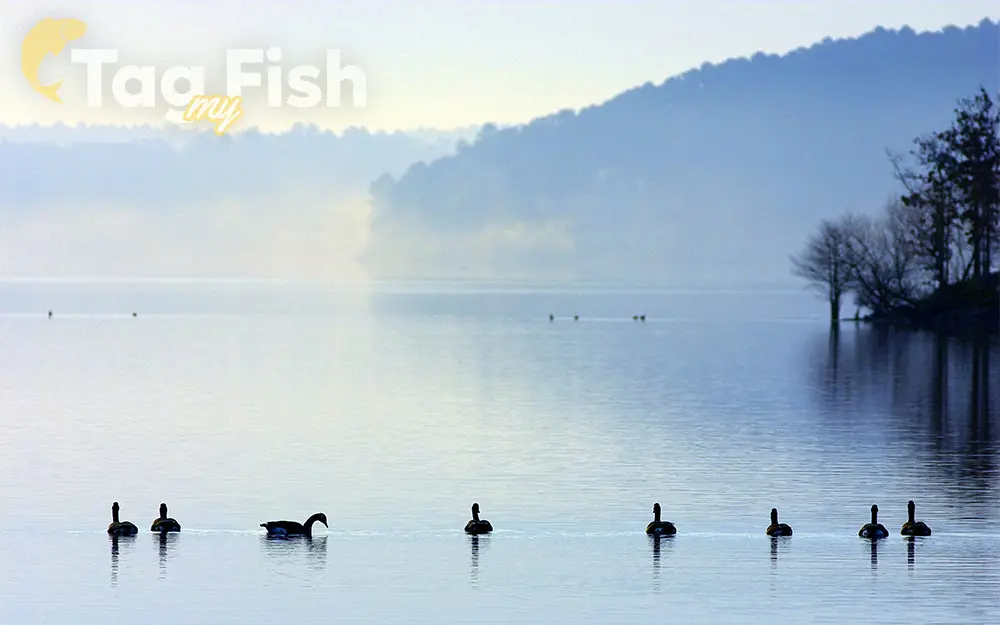DeGray Lake

General data
- Name: DeGray Lake
- Water system: Atchafalaya River
- Water type: Artificial lake
- Progression: Caddo River -> Ouachita River -> Black River (Red River tributary) -> Red River of the South -> Atchafalaya River -> Gulf of Mexico -> Atlantic Ocean -> Planet Earth
- Climates: Subtropical
- Continents: North America
- Countries: United States of America
DeGray Lake is a reservoir on the Caddo River constructed by the United States Army Corps of Engineers in Arkansas, 8 miles (13 km) from Arkadelphia. Arkansas Scenic Byway 7 is located on the eastern shore of the lake, and provides views of the lake, and also places to stay. DeGray Lake Resort State Park was opened in 1974 to encourage tourism and recreation on DeGray Lake. The DeGray Dam project, encompassing flood-control, power, and water-supply features is located in northern Clark County, Arkansas on the Caddo River approximately eight miles above its confluence with the Ouachita River. The project plan for DeGray Lake included the construction of the DeGray Dam with a height of 240 feet above the Caddo River, a dike that splits the Caddo River and Bayou de Roche, an outlet works, an uncontrolled spillway, and a powerhouse. DeGray Lake supports a variety of game and non-game wildlife. Squirrels and rabbits predominate as upland game. Deer, beaver, turkey, raccoon, armadillo, quail, and doves are found in moderate numbers. Very few waterfowl nest along the Caddo River, but the lake will provide a resting stop for migratory birds. A variety of songbirds with other birds, such as hawks, owl, herons, and vultures, are either permanent residents or migrate through the DeGray area. Bald eagles have been sighted on the lake during the winter months. The lake has inundated habitats that once supported deer, squirrel, beaver, and wild turkey. Management of peripheral lands have determined whether these remaining habitats are destroyed either through structural or human invasion. The hardwood forest is unique to the area, and this habitat will be preserved. Cleared lands will be maintained as existing habitat for deer, quail, dove, and rabbits. Large tracts of land, not suited for recreational development, will be set aside to preserve wildlife habitats, both for hunting purposes and the encouragement of non-game species. DeGray Lake, with 13,420 surfaces acres at full power pool has the potential for providing a substantial annual sport fishery. In addition to natural fisheries recruitment from original Caddo River populations, the Arkansas Game and Fish Commission initiated a supplemental fish stocking program in 1969. Black bass, catfish, Red-ear, bluegill, crappie, and white bass were stocked followed by stockings of shad for forage supplement. To provide sport fishing variety and to supplement the predator population, exotic species (walleye, northern pike and muskellunge) were also stocked. Fish populations in DeGray Lake are still in the growth period and have not yet reached full potential. However, good bass, bream, and crappie fishing has been realized. Some catches of northern pike have been reported but the fate of the walleye and muskellunge stockings is unknown. Because of their similarity, some of the northern pike reported caught may have actually been muskellunge. Sampling efforts have not indicated that any of the exotic species are reproducing in the lake. Maintenance of the remaining downstream warm-water ecosystem is possible as a result of the multilevel intake structure in the dam. This structure can selectively withdraw water from a vertical range of nearly 60 feet, thereby allowing withdrawals to occur from strata of desired temperature. The 90-acre reregulating pool below most hydroelectric systems. As a result, smallmouth and rock bass, warmouth, red-ear, sunfish, and channel catfish are caught on the lower Caddo River.

 English
English
 Spanish
Spanish
 German
German
 French
French
 Serbian
Serbian
 Russian
Russian

